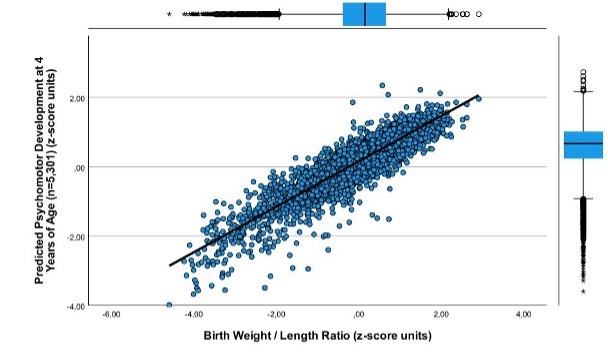Simple measures at birth predict development at preschool age - Unique index discovered
October 27, 2022 (PRLEAP.COM) Health News
Weight and length at birth determine psychomotor development at 4 years of age
Bochum's medics have discovered a simple method to predict psychomotor development at 4 years preschool age. They prospectively screened 5,301 infants by cranial ultrasound and extrapolated the results of a previous study from the same center in which both cranial ultrasound and psychomotor development (Intelligence quotient (IQ), Maze test (MT), and Neurologic examination (NOS)) were measured. Most interestingly, the birth weight divided by body length (weight-length ratio) correlated closely with the predicted average overall development score (pTPMDS). "This close relation between simple growth variables at birth and development at preschool age allows for early intervention and support strategies to improve school performance and educational success later in life", says Prof. Dr. Arne Jensen of the Campus Clinic Gynaecology at the Ruhr-University Bochum, and continues: "this is particularly important for those infants that are born seemingly healthy that would normally escape further diagnostic assessment. Together with his colleague Gerd Neuhäuser, MD, he reports in the "American Journal of Obstetrics and Gynecology Global Reports" (https://www.ncbi.nlm.nih.gov/pmc/articles/PMC9579794/).
Links:
Jensen A, Neuhäuser G, Jensen KO. Growth variables and brain damage at birth predict developmental disability at four years of age: a basis for individual preschool support. Ann Pediatr. 2019;2:1017. [https://ots.de/Vue0wY]
Jensen A.Pediatric stroke and cell-based treatment - Pivotal role of brain plasticityJ Stem Cell Res Transplant. 2019; 6(1): 1029, 22 pages [https://ots.de/uumNCq]
Jensen A, Holmer B. "White Matter Damage in 4,725 Term-Born Infants Is Determined by Head Circumference at Birth:
The Missing Link," Obstetrics and Gynecology International, vol. 2018, Article ID 2120835, 12 pages, 2018. [doi:10.1155/2018/2120835 https://ots.de/Sd92nV]
Bibliographic record
Jensen A, Neuhäuser G. Association of weight-length ratio at birth with psychomotor trajectories among preschool-aged children. AJOG Glob Rep. 2022 Oct 2;2(4):100115. doi: 10.1016/j.xagr.2022.100115. PMID: 36275404; PMCID: PMC9579794.
Figures
Figure: The close relation between predicted total psychomotor development score (pTPMDS) at 4 years of age and the weight-length ratio (W/L) (z-score units) in 5,301 newborns (Jensen A, Neuhäuser G. https://www.ncbi.nlm.nih.gov/pmc/articles/PMC9579794/).
